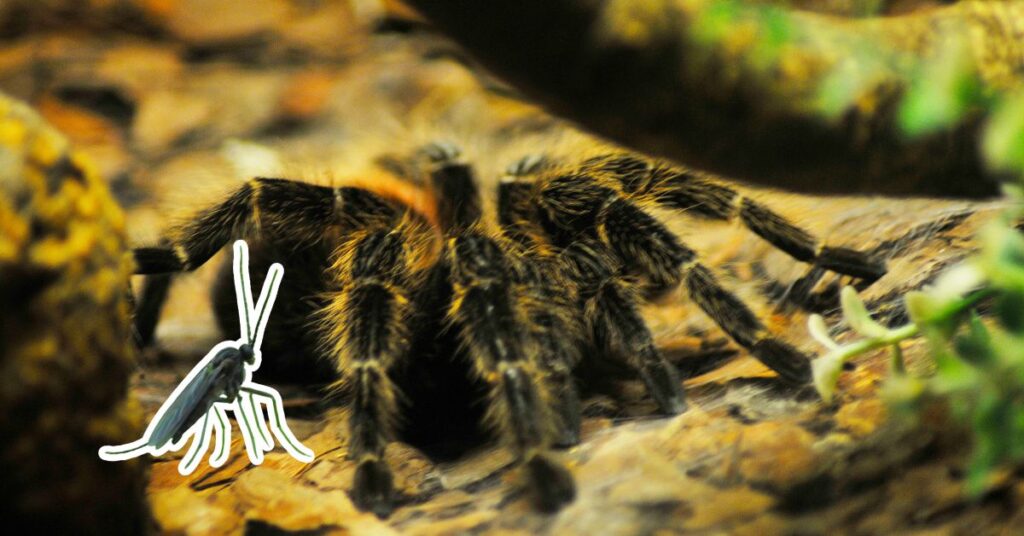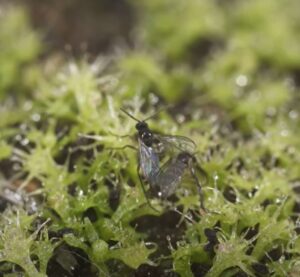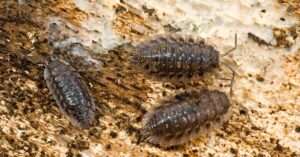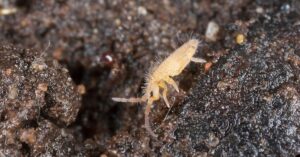
Fungus gnats lay their eggs in moist organic debris or soil, which hatch into larvae. But are fungus gnats harmful to tarantulas? The larvae feed on organic matter. They eventually become pupae and then adults emerge from the pupae. Needless to say, a tarantula enclosure is the perfect environment for them. Let’s find out if they’re actually harmful.
Adult gnats don’t bite so other than being irritating, they don’t pose a huge problem to tarantulas and will tend to leave your tarantula alone. Only if the infestation becomes large and the gnats become crowded, might they start to bother your spider. Their ultimate goal is to get out of the cage and go elsewhere.
And there you have it. They’re not likely to harm your tarantula although you will want to get rid of them as soon as possible to stop them from taking over the enclosure and putting stress onto your spider.
Where do Fungus Gnats Come From?
Fungus Gnats usually arrive at the home via a new plant or anything that contains some type of compost. As larvae they are virtually impossible to see so if you do get them, don’t blame the Garden Centre or wherever you got the soil from, it’s not their fault.
What is the Life Cycle of a Fungus Gnat?
As we have already established, the gnats will lay their eggs in moist organic compost, soil or debris. They are eggs for the first three days, ten days as larvae and then four days as pupae.
Warmer temperatures allow more rapid development which is why a tarantula enclosure with higher humidity will see a more rapid production of these pests.
Their life cycle only lasts around four weeks, but your enclosure can soon become overpopulated if you don’t rectify the situation as soon as possible.
How do I Know I Have Fungus Gnats in my Tarantula Enclosure?
Fungus Gnats range in size from about ⅛-1/4 inch long. They have very long legs compared to the overall size of their body. Most the fungus gnat species are black in colour and have a long, slender abdomen.
How Do I Get Rid of Fungus Gnats?
There are several tried and tested methods of getting rid of these annoying creatures.
Fly Catchers
If your infestation isn’t that bad, a quick and easy way to get rid of them is to use fly tape. Simply put the sticky yellow piece of tape in a place your tarantula can’t reach.
Alternatively, you can make a trap from a small strip of wax paper, vaseline and a leftover cricket or other piece of bait. Don’t forget to place it high out of your tarantulas reach!
Dry out the Enclosure
Allow your enclosure to become completely dry. If you’re dealing with a high humidity species, you may wish to try adding some iron-rich sand to the enclosure.
Due to its high iron concentration, it’s been known to prevents flies from breeding. You only need a few tablespoons of the sand per enclosure, and it isn’t harmful to the tarantula.
It is even possible to use with slings.
Woodlouse/Roly-Poly Bugs
If you are at the early stages of infestation, introduce some woodlice into the enclosure. They are harmless to your tarantula and will efficiently clean up anything that might develop into a problem later on.
Springtails
Again, Springtails are completely harmless to your tarantula and make a great clean up crew, not just for gnats, but for any organic or rotting matter your tarantula may leave after a meal.
In fact, Springtails are often recommended to keep in your tarantula’s enclosure regardless, exactly for this purpose.
Use Peat Moss
Whilst peat moss doesn’t prevent the flies from laying eggs, the acidity prevents the eggs from turning into larva.
Completely Clean the Enclosure
If all else fails, and if you haven’t done this for a while, now might be a good time to do so. Move your tarantula to a separate, un-infested enclosure and give his home a complete spring clean.
Remove all substrate, replace any organic matter, (plants and soil etc) and maybe even add some of the above-mentioned ideas to prevent you from having to repeat this process again so soon.
Tarantulas get very stressed when they’re moved from one enclosure to another so the less frequently you can do this, the better.
Anecdotal Solutions
Wine
It has been suggested to leave out a cup of wine in the affected area where the tarantula cannot reach it. The gnats are attracted to alcohol and drown (whether its because they’re drunk, no-one knows!)
Vinegar
Another anecdotal solution is to leave a glass of vinegar out. Cover the top and place holes in so that the gnats can get it but can’t get out again. The smell is another thing that attracts them apparently.
Ketchup
Apparently, ketchup works too. One person reported to taking an almost empty ketchup bottle, unpopping the top and leaving it there overnight. The next day, he corked the bottle and removed it and there were at least two dozen of them in there.
General Husbandry
Once you have the infestation under control, you should always perform good husbandy when it comes to keeping your tarantula’s enclosure clean. More on that in a separate article.
We hope we have answered the question and hopefully helped you get rid of these annoying little insects!
Until next time, stay spidery!



